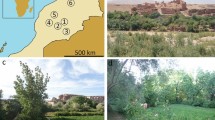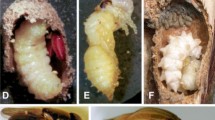Summary
Solitary and social nests of the facultatively social carpenter bee Xyclopa pubescens can be found simultaneously during the major part of the breeding season. Social nests contain a reproductively dominant forager and either her adult offspring or a formerly reproductive, guarding female. The costs and benefits to the dominant animal of allowing a defeated female to remain as a guard in the nest were analysed in terms of brood loss and brood gain. The costs included the probability that the guard would regain reproductively dominant status. The most important benefits were the protection that a guard provided against pollen robbery by conspecifics and the longer foraging time available to a forager when her nest was protected. The balance between costs and benefits depended on the severity of ecological constraints. During certain periods of intense competition for pollen or nests, the benefits clearly outweighed the costs.
Similar content being viewed by others
References
Anzenberger G (1977) Ethological study of African carpenter bees of the genus Xylocopa (Hymenoptera, Anthophoridae). Z Tierpsychol 44:337–374
Batra SWT (1964) Behavior of the social bee Lasioglossum zephyrum, within the nest (Hymenoptera, Halictidae). Insectes Soc 11:159–186
Ben Mordechai Y, Cohen R, Gerling D, Moscovitz E (1978) The biology of Xylocopa pubescens (Spinola) (Hymenoptera: Anthophoridae) in Israel. Isr J Entomol 12:107–121
Blom J van der, Velthuis HHW (1988) Social behaviour of the carpenter by Xylocopa pubescens Spinola. Ethology 79: 281–294
Bonelli B (1976) Osservatione eto-ecologcae sugli Imenotteri aculeati dell'Etiopia. VII. Xylocopa (Mesotrichia) combusta Smith (Hymenoptera-Anthophoridae). Boll Ist Entomol Univ Studi Bologna 32:105–132
Brown JL, Brown ER, Brown SD, Dow DD (1982) Helpers: Effect of experimental removal on reproductive success. Science 215:1412–1422
Camillo E, Garofalo CA (1989) Social organization in reactivated nests of three species of Xylocopa (Hymenoptera, Anthophoridae) in Southeastern Brasil. Insectes Soc 36:92–105
Caraco T, Wolf LL (1975) Ecological determinants of group sizes of foraging lions. Am Nat 109:343–352
Cruden RW (1966) Observations on the behavior of Xylocopa c. californica and X. tabaniformis orpifex. Pan-Pac Entomol 42:111–119
Deag JM (1972) Aggression and submission in monkey societies. Anim Behav 25:465–474
Emlen ST (1982) The evolution of helping. I. An ecological constraints model. Am Nat 119:29–39
Emlen ST (1984) Cooperative breeding in birds and mammals.In: Krebs JR, Davies NB (eds) Behavioural ecology: an evolutionary approach, 2nd edn. Blackwell, Oxford, pp 305–339
Emlen ST (1990) White-fronted bee eaters: helping in a colonially nesting species. In: Stacey PB, Koenig WD (eds) Cooperative breeding in birds: long-term studies of ecology and behavior. Cambridge Univ Press, Cambridge New York Port Chester Melbourne Sidney, pp 487–526
Emlen ST, Wrege PH (1989) A test of alternate hypotheses for helping behavior in white-fronted bee-eaters of Kenya. Behav Ecol Sociobiol 25:303–319
Faabourg J, Bernardz J (1990) Galapagos and Harris hawks: Divergent causes of sociality in two raptors. In: Stacey PB, Koenig WD (eds) Cooperative breeding in birds: Long-term studies of ecology and behavior. Cambridge Univ Press, Cambridge New York Port Chester Melbourne Sidney, pp 357–383
Gamboa GJ (1978) Interspecific defense: Advantage of social cooperation among paper wasp foundresses. Science 199:1463–1465
Gaston AJ (1978) The evolution of group territorial behavior and cooperative breeding. Am Nat 112:1091–1100
Gerling D (1983) Nesting biology and flower relationships of Xylocopa sonorina Smith in Hawaii (Hymenoptera: Anthophoridae). Pan-Pac Entomol 58(4):336–351
Gerling D, Hermann HR (1978) Biology and mating behavior of Xylocopa virginica L. (Hymenoptera, Anthophoridae). Behav Ecol Sociobiol 3:99–111
Gerling D, Hurd PD, Hefetz A (1981) In-nest behavior of the carpenter bee Xylocopa pubescens Spinola (Hymenoptera:Anthophoridae). J Kansas Entomol Soc 54:209–218
Gerling D, Hurd PD, Hefetz A (1983) Comparative behavioral biology of two Middle East species of carpenter bees (Xylocopa Latreille) (Hymenoptera:Apoidea). Smithsonian Contrib Zool 369
Gerling D, Velthuis HHW, Hefetz A (1989) Bionomics of the large carpenter bees of the genus Xylocopa. Anna Rev Entomol 34:163–190
Hamilton WD (1964) The genetical evolution of social behavior I & II. J Theor Biol 7:1–52
Hughes CR, Strassmann JE (1988) Foundress mortality after worker emergence in social wasps (Polistes). Ethology 79:265–280
Hurd PD Jr (1958) Obsersations on the nesting habits of some new world carpenter bees with remarks on their importance in the problem of species formation (Hymenoptera:Apoidea). Pan-Pac Entomol 42:111–119
Klahn J (1988) Interspecific comb usurpation in the social wasp Polistes fuscatus. Behav Ecol Sociobiol 23:1–8
Klahn JE, Gamboa GJ (1983) Social wasps: discrimination between kin and nonkin brood. Science 221:482–484
Lin N (1964) Increased parasitic pressure as a major factor in the evolution of social behavior in halictine bees. Insectes Soc 11:187–192
Lin N, Michener CD (1972) Evolution of sociality in insects. Q Rev Biol 47:131–159
Litte M (1977) Behavioural ecology of the social wasp Mischocyttarus mexicanus. Behav Ecol Sociobiol 2:229–246
MacDonald J, Matthews RW (1975) Vespula squamosa: a yellow jacket wasp evolving towards parasitism. Science 190:1003–1004
Malyshev SJ (1931) Lebensgeschichte der Holzbienen, Xylocopa Latr. (Apoidea). Z Morphol Ökol Tiere 23:754–809
Mason CA (1987) Division of labor and nestmate interactions in two species of allodapine bees. In: Eder J, Reinhold H (eds) Chemistry and biology of social insects. Peperney, München, p 276
Michener CD (1964) Reproductive efficiency in relation to colony size in hymenopterous societies. Insectes Soc 11: 317–342
Michener CD (1969) Comparative social behavior of bees. Annu Rev Entomol 14:299–342
Michener CD (1971) Biologies of the African allodapine bees (Hymenoptera, Xylocopinae). Bull Am Mus Nat Hist 145:221–301
Michener CD (1974) The social behavior of the bees: a comparative study. Harvard University Press, Cambridge Mass
Michener CD (1990) Castes in xylocopine bees. In: Engels W (ed) Social insects: an evolutionary approach to castes and reproduction. Springer, Heidelberg, pp 123–146
Noonan KM (1981) Individual strategies of inclusive-fitness-maximizing in Polistes fuscatus foundresses. In: Alexander RD, Tinkle DW (eds) Natural selection and social behavior. Chiron Press, New York, pp 18–44
Nudds T (1978) Convergence of group size strategies by mammalian social carnivores. Am Nat 112:957–960
Packer L (1990) Solitary and eusocial nests in a population of Augochlorella striata (Provancher) (Hymenoptera; Halictidae) at the northern edge of its range. Behav Ecol Sociobiol 27:339–344
Rowley I, Russell E (1990) Splendid Fairy-wrens: demonstrating the importance of longevity. In: Stacey PB, Koenig WD (eds) Cooperative breeding in birds: long-term studies of ecology and behavior. Cambridge Univ Press, Cambridge New York Port Chester Melbourne Sidney, pp 1–30
Sakagami SF, Maeta Y (1977) Some presumably presocial habits of Japanese Ceratina bees, with notes on various social types in Hymenoptera. Insectes Soc 24:319–343
Sakagami SF, Maeta Y (1987) Multifemale nests and rudimentary castes of an “almost” solitary bee Ceratina flavipes, with additional observations on multifemale nests of Ceratina japonica (Hymenoptera, Apoidea). Kontyu 55:391–409
Schaik CP van (1983) Why are diurnal primates living in groups? Behaviour 87:120–144
Schwarz MP (1988) Local resource enhancement and sex ratios in a primitively social bee. Nature 331:346–348
Smith BH, Weller C (1989) Social competition among gynes in halictine bees: The influence of bee size and pheromones on behavior. J Insect Behav 2:397–411
Stark RE (1989) Beobachtungen zur Nestgriindung and Brutbiologie der Holzbiene Xylocopa sulcatipes Maa (Apoidea:Anthophoridae). Mitt Dtsch Ges Allg Angew Entomol 7:252–256
Stark RE (1992) Cooperative nesting in the multivoltine large carpenter bee Xylocopa sulcatipes Maa (Apoidea: Anthophoridae): Do helpers gain or loose to solitary females? Ethology 91:301–310
Stark RE, Hefetz A, Gerling D, Velthuis HHW (1990) Reproductive competition involving oophagy in the socially nesting bee Xylocopa sulcatipes. Naturwissenschaften 77:38–40
Velthuis HHW (1987) The evolution of sociality: Ultimate and proximate factors leading to.primitive social behaviour in carpenter bees. In: Pasteels JM, Deneubourg JL (eds) From individual to collective behaviour in social insects. Birkhauser, Basel, pp 405–434
Velthuis HHW, Gerling D (1983) At the brink of sociality: Interactions between adults of the carpenter bee Xylocopa pubescens Spinola. Behav Ecol Sociobiol 12:209–214
Watmough RH (1974) Biology and behaviour of carpenter bees in Southern Africa. J Entomol Soc S Afr 37:261–281
West Eberhard MJ (1969) The social biology of polistine wasps. Misc Publ Mus Zool, Univ Mich 140:1–101
Woolfenden GE (1981) Selfish behavior by Florida scrub jay helpers: In: Alexander RD, Tinkle DW (eds) Natural selection and social behavior. Chiron Press, New York, pp 257–260
Yanega D (1989) Caste determination and differential diapause within the first brood of Halictus rubicundus in New York (Hymenoptera:Halictidae). Behav Feel Sociobiol 24:97–107
Zahavi A (1974) Communal nesting by the Arabian babbler: A case of individual selection. Ibis 116:84–87
Author information
Authors and Affiliations
Additional information
Correspondence to: K. Hogendoorn
Rights and permissions
About this article
Cite this article
Hogendoorn, K., Velthuis, H.H.W. The sociality of Xylocopa pubescens: does a helper really help?. Behav Ecol Sociobiol 32, 247–257 (1993). https://doi.org/10.1007/BF00166514
Received:
Accepted:
Issue Date:
DOI: https://doi.org/10.1007/BF00166514




